|
|
|
Sort Order |
|
|
|
Items / Page
|
|
|
|
|
|
|
| Srl | Item |
| 1 |
ID:
140004


|
|
|
|
|
| Summary/Abstract |
As the end of 2015 draws nearer, the prospect of meeting all the goals of the ASEAN Economic Community (AEC) Blueprint appears dimmer by the day. The literature identifies two prominent gaps in ASEAN’s journey towards an economic community as defined by its own vision. First, the extensive literature on the AEC, and this includes the scorecard designed to monitor the implementation of its goals, suggests that there appears to be a gap between commitments and the achievements of the AEC Blueprint targets. Second, attaining a “free flow of services” as stated in the AEC goals, is also hampered by a gap between commitments in liberalization and actual practice. The objectives of this paper are twofold. First, it seeks to review the gap between commitments and practice in Malaysia. Second, it aims to examine domestic conflicts that may constrain Malaysia’s services liberalization efforts in ASEAN. A key question considered in the analysis is the source or sources of these conflicts. Is the conflict confined to the private sector or is the government conflicted from within in terms of services liberalization? In other words, are there certain policies that may negate or off-set liberalization efforts? The key finding in this paper shows conflicting objectives in government policies to be the main reason for the slow pace of liberalization thus far.
|
|
|
|
|
|
|
|
|
|
|
|
|
|
|
|
| 2 |
ID:
129969
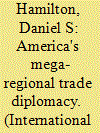

|
|
|
|
|
| Publication |
2014.
|
| Summary/Abstract |
The United States is currently negotiating two massive regional economic agreements, one with 11 Asian and Pacific Rim countries and the other with the 28-member European Union. The Trans-Pacific Partnership (TPP) and the Transatlantic Trade and Investment Partnership (TTIP) herald a substantial shift in US foreign economic policy as Washington turns its focus from the stalemated Doha Round of multilateral trade negotiations and scattered bilateral trade agreements to 'mega-regional' trade diplomacy. As the only party to both negotiations, Washington seeks to leverage issues in one to advance its interests in the other, while reinvigorating US global leadership.
|
|
|
|
|
|
|
|
|
|
|
|
|
|
|
|
| 3 |
ID:
178417
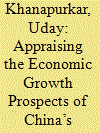

|
|
|
|
|
| Summary/Abstract |
This article examines the economic growth prospects of China’s services sector. Reportage on China’s economy and its data releases tends to focus largely on aggregate GDP growth, manufacturing growth, retail sales and investments, and fails to adequately cover services despite them being the largest contributor to growth. The article parses the growth of China’s various services subcomponents across a range of parameters and assesses that the industry has come under duress with a slowdown in complementary manufacturing and the dissipation of growth bubbles in finance and real estate. It is further observed that reforms necessary for spurring services growth are at a nascent stage, proceed slowly, and are imperilled by GDP growth targets that result in policies favouring the manufacturing industry. In sum, while China’s services growth prospects are hardly in dire jeopardy due to favourable demand-side conditions, achieving potential and affecting convergence with high income countries will necessitate the expedition of reforms and the engineering of a sustained high growth phase in the sector.
|
|
|
|
|
|
|
|
|
|
|
|
|
|
|
|
| 4 |
ID:
139461


|
|
|
|
|
| Summary/Abstract |
This paper unearths an alternative paradigm through which to consider the discussions and debates between members of the Indian public, government bureaucrats and Congress Party politicians about the rights and interests of Indian citizens both before and immediately after India's Independence in 1947. It argues that much of the recent historical work on citizenship during this period has been preoccupied with issues of nationality and religious community as a result of the fallout from Partition. However, the demands and deliberations over the introduction of provincial forms of affirmative action in the all-India services at this time are indicative of a different narrative. First, many provincial representations of ‘minority’ rights often took into account differences of caste and language instead. Second, and perhaps more importantly, the term minority was employed not only to describe demographic minority status, but also to define under-represented groups in the all-India services. In doing so, these different provincial policies prioritised particular local rights to representation, in which citizenship was expressed through a regional idiom.
|
|
|
|
|
|
|
|
|
|
|
|
|
|
|
|
| 5 |
ID:
119151


|
|
|
|
|
| Publication |
2013.
|
| Summary/Abstract |
The present study investigates the main determinants of the employment share of the service sector using a panel of 66 countries over the period 1983-2007. Based on alternative measures of currency misalignment, the study extends the literature by investigating the impact of an undervalued currency on services. The empirical findings show that together with productivity and income per capita, currency undervaluation significantly determines the total employment share of services. Another key finding is that conventional crosscountry determinants and the exchange rate undervaluation can only partially explain the underdevelopment of services activity in China and in other South-East Asian countries. In these countries, policies that aim at rebalancing the economy towards services should include elements to reform the domestic financial market, and the social security and healthcare systems.
|
|
|
|
|
|
|
|
|
|
|
|
|
|
|
|
| 6 |
ID:
099815
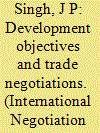

|
|
|
|
|
| Publication |
2010.
|
| Summary/Abstract |
To what extent do trade negotiations deliver on development objectives articulated from the developing world? In the past, the developed world deployed moralistic foreign policies and largesse to placate the developing world. The article examines the ways in which the global power configurations are now changing to allow developing countries to gain concessions instead through negotiations that are consistent with their development aspirations. It first provides a brief negotiation history of the developing world's relationship with the General Agreement on Tariffs and Trade (GATT) through the lens of development. The article then analyzes the intellectual property and agricultural negotiations at the current Doha Round of the World Trade Organization (WTO) to conclude that the developed world's preferred outcome remains moral largesse rather than making trade concessions.
|
|
|
|
|
|
|
|
|
|
|
|
|
|
|
|
| 7 |
ID:
188711


|
|
|
|
|
| Summary/Abstract |
While states and non-state armed groups often engage in militarised conflict over contested territory, at other times they co-govern in a tenuous equilibrium. Using a survey of over 1,600 Kurdish soldiers (Peshmerga) and elite interviews, we investigate local variation in shared governance in one such context – the disputed territories of northern Iraq. Despite the area being under Kurdish military control, the Iraqi government continued to provide services in districts where it had pre-existing infrastructural capacity. However, in revenue-producing districts, Kurdish actors appropriated infrastructural power to provide services themselves. This illustrates that non-state governance strategies, and their outputs, can vary locally.
|
|
|
|
|
|
|
|
|
|
|
|
|
|
|
|
| 8 |
ID:
105899


|
|
|
|
|
| Publication |
2011.
|
| Summary/Abstract |
In 2006, the European Union (EU) Services Directive entered into force. Member states were required to give effect to its provisions before 28 December 2009. According to its preamble, the directive sets out a general legal framwork dealing with a range of services. The aim of the directive is to remove barriers to the free movement of services and service providers. This serves the further aim of creating, by 2010, an internal market in services. The EU internal market consists of just under 500 million people in 27 member states. On the other side of the world, the EU Services Directive has been considered by some as offering a blueprint for better integrating the services market in Australia. However, the Australian 'internal market' consists of not quite 22 million people in six states and two territories. Its legal system belongs to the common law family, whereas the EU legal system, although a sui generis one, is nevertheless unavoidably influenced by the civil law tradition of the majority of its member states. Using the functional approach towards comparative law, this article examines the Australian and EU experiences of integrating the services market, taking the recent EU Services Directive as the focal point for discussion. The article begins with an overview of this directive before exploring the similarities and differences in the two legal systems. The purpose of this comparative analysis is to test whether the EU does hold any lessons for Australia in liberalising services markets or whether, instead, there might be lessons for the EU from Australia.
|
|
|
|
|
|
|
|
|
|
|
|
|
|
|
|
| 9 |
ID:
146906
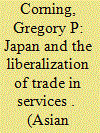

|
|
|
|
|
| Summary/Abstract |
This paper argues that political rather than economic motivations explain Japan’s approach to services negotiations but that the Trans-Pacific Partnership and Trade in Services Agreement present Japan with opportunities to advance liberalization in services as well as to pursue political gains in the competition for regional leadership with China.
|
|
|
|
|
|
|
|
|
|
|
|
|
|
|
|
| 10 |
ID:
177816


|
|
|
|
|
| Summary/Abstract |
A slew of structural changes to the People’s Liberation Army’s (PLA) combat capabilities, deterrence as well as military operations other than war (MOOTW) were enacted following the announcement to streamline China’s armed forces in September 2015. Primarily driven by the Chinese military leadership’s desire to resolve longstanding shortcomings in the PLA’s ability to conduct combined arms and joint operations, unprecedented changes in the form of so-called ‘below the neck’ reforms gathered pace since the end of 2016. By focusing on those changes to the PLA’s established service branches as well as ‘new types’ of forces, this brief introduction will provide a summary of the prospects and problems as the Chinese military embarks on its latest endeavour to modernize itself.
|
|
|
|
|
|
|
|
|
|
|
|
|
|
|
|
| 11 |
ID:
143537
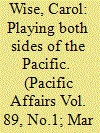

|
|
|
|
|
| Summary/Abstract |
One of the most prominent trends in Latin America in the 2000s has been the proliferation of bilateral free trade agreements (FTAs) across the Pacific basin. Beginning with the path-breaking Chile-Korea FTA in 2004 up to the Costa Rica-Singapore FTA in 2013, the past decade has seen the negotiation of twenty-two cross-Pacific accords. China, too, has jumped on to the cross-Pacific FTA bandwagon, including its negotiation of separate bilateral FTAs with Chile (2006), Peru (2009), and Costa Rica (2011). This paper analyzes the origins, content, and preliminary outcomes of these three China-Latin America FTAs. The findings are threefold: 1) in contrast with other cross-Pacific FTAs, which include at least one developed country, the three FTAs analyzed in this paper constitute “south-south” FTAs; yet, in contrast with other south-south FTAs, these three China-Latin America accords approximate WTO+ standards vis-à-vis the World Trade Organization (WTO) and its new trade agenda (services, investment, and intellectual property rights); 2) although the motives for negotiating these developing- developing country accords varied, on the part of China and the countries themselves, this did not disrupt the march toward WTO+ status; and 3) while all three of these FTAs elude standard theoretical explanations for the negotiation of bilateral FTAs, the three Latin American countries do share similar reform trajectories and institutional affinities, which sheds light on the decision and capacity of each to negotiate a bilateral FTA with China.
|
|
|
|
|
|
|
|
|
|
|
|
|
|
|
|
| 12 |
ID:
146696
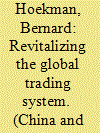

|
|
|
|
|
| Summary/Abstract |
Since 2008, G20 leaders have repeatedly committed themselves not to resort to protectionism and to conclude WTO negotiations expeditiously. The jury is out on the extent to which they have lived up to the first promise; they have failed to deliver the second. Anemic global trade growth rates since 2010 imply that trade has not been a driver of much-needed economic dynamism. This paper argues that the G20 should pursue a more ambitious trade agenda and that there is much that greater leadership by the G20 could do to reinvigorate the trading system. A first step would be to commit to concrete actions that can be implemented by individual governments on a concerted basis and that center on reducing trade costs and improving access to services for firms. The Chinese presidency should also seek to have the G20 commit to more effective monitoring and analysis of trade policy broadly defined (including subsidies and investment incentives) and the impact of the many preferential trade agreements involving China, the EU and the USA, the world's largest trading powers.
|
|
|
|
|
|
|
|
|
|
|
|
|
|
|
|
| 13 |
ID:
182981


|
|
|
|
|
| Summary/Abstract |
The COVID-19 pandemic caused a lockdown of Wuhan, and strict control was imposed in many major Chinese cities, including the national capital of Beijing. Residents’ committee workers at the grass-roots level have played a critical role in the enforcement of the government’s pandemic prevention and control measures, through their day-to-day service and surveillance as local community managers. This article examines their work in Wuhan and Beijing neighbourhoods during the most critical periods of the outbreak, from late January to June 2020, and the challenges the workers faced as executors of the government’s community-based prevention policy. The two cities have developed different community strategies because of very different epidemiological situations and city functions.
|
|
|
|
|
|
|
|
|
|
|
|
|
|
|
|
| 14 |
ID:
161487


|
|
|
|
|
| Summary/Abstract |
The article studies the impact of outsourcing services on the productivity growth of the Indian manufacturing firms. By the term services we mean different expenses on services incurred by the manufacturing firms, such as, advertising, marketing, research and development, consultancy, auditing, business services, knowledge-based services, technical, legal and other professional services (including information communication and technology services). With further expansion in newer services, a higher demand has come from the Indian manufacturing sector. With intensive usage of services in the manufacturing production process, the performance and the manufacturing can focus on the core competencies with outsourced and cheaper services from expert service provider. For this purpose, the firm-level data have been collected from the annual financial statements of the Centre for Monitoring of the Indian Economy’s Prowess database. The econometric results conclude that services have played a positive role in improving the productivity growth of the aggregate Indian manufacturing firms and at the disaggregated level, especially for industrial groups such as food, beverage and tobacco; textiles, gems and jewellery; transport; machinery; metal, rubber and plastic; leather and footwear; and chemicals, services have played a favourable role in boosting the productivity growth.
|
|
|
|
|
|
|
|
|
|
|
|
|
|
|
|
|
|
|
|
|